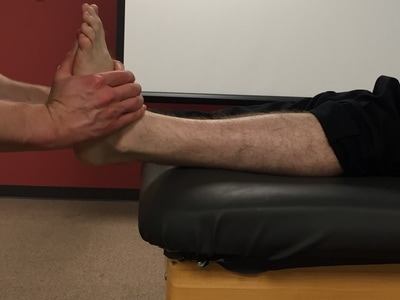- Home
- About Us
- TSPT Academy
- Online Courses
-
Resources
- Newsletter
- Business Minded Sports Physio Podcast
- Day in the Life of a Sports PT
- Residency Corner
-
Special Tests
>
-
Cervical Spine
>
- Alar Ligament Test
- Bakody's Sign
- Cervical Distraction Test
- Cervical Rotation Lateral Flexion Test
- Craniocervical Flexion Test (CCFT)
- Deep Neck Flexor Endurance Test
- Posterior-Anterior Segmental Mobility
- Segmental Mobility
- Sharp-Purser Test
- Spurling's Maneuver
- Transverse Ligament Test
- ULNT - Median
- ULNT - Radial
- ULNT - Ulnar
- Vertebral Artery Test
- Thoracic Spine >
-
Lumbar Spine/Sacroiliac Joint
>
- Active Sit-Up Test
- Alternate Gillet Test
- Crossed Straight Leg Raise Test
- Extensor Endurance Test
- FABER Test
- Fortin's Sign
- Gaenslen Test
- Gillet Test
- Gower's Sign
- Lumbar Quadrant Test
- POSH Test
- Posteroanterior Mobility
- Prone Knee Bend Test
- Prone Instability Test
- Resisted Abduction Test
- Sacral Clearing Test
- Seated Forward Flexion Test
- SIJ Compression/Distraction Test
- Slump Test
- Sphinx Test
- Spine Rotators & Multifidus Test
- Squish Test
- Standing Forward Flexion Test
- Straight Leg Raise Test
- Supine to Long Sit Test
-
Shoulder
>
- Active Compression Test
- Anterior Apprehension
- Biceps Load Test II
- Drop Arm Sign
- External Rotation Lag Sign
- Hawkins-Kennedy Impingement Sign
- Horizontal Adduction Test
- Internal Rotation Lag Sign
- Jobe Test
- Ludington's Test
- Neer Test
- Painful Arc Sign
- Pronated Load Test
- Resisted Supination External Rotation Test
- Speed's Test
- Posterior Apprehension
- Sulcus Sign
- Thoracic Outlet Tests >
- Yergason's Test
- Elbow >
- Wrist/Hand >
- Hip >
- Knee >
- Foot/Ankle >
-
Cervical Spine
>
- I want Financial Freedom
- I want Professional Growth
- I want Clinical Mastery
External Rotation Test
Purpose: To help identify a tibiofibular syndesmotic injury (high ankle sprain).
Test Position: Supine or Sitting.
Performing the Test: The examiner maintains ankle dorsiflexion and externally rotates the foot on a stabilized leg. A positive test occurs when pain in recreated in the area over the interosseous membrane (syndesmosis region).
Diagnostic Accuracy: Sensitivity: .20; Specificity: 84.5
Importance of Test: The term "high ankle sprain" refers to an isolated injury to the tibiofibular syndesmosis. Syndesmotic sprains occur in about 10-20% of all ankle sprains. The stability of the syndesmosis in dependent on the surrounding bones and ligaments, in particular the anterior inferior tibiofibular ligament (AITFL), the posterior inferior tibiofibular ligament (PITFL), interroseous ligament, and the inferior transverse ligament. Normal motion of the tibiofibular syndesmosis is 1 to 1.25 mm with dorsiflexion of the talus. When the ligamentous stability of the syndesmosis is altered the motion can significantly increase and creates a mechanical instability.
Note: these tests should only be performed by a properly trained health care practitioner.
Test Position: Supine or Sitting.
Performing the Test: The examiner maintains ankle dorsiflexion and externally rotates the foot on a stabilized leg. A positive test occurs when pain in recreated in the area over the interosseous membrane (syndesmosis region).
Diagnostic Accuracy: Sensitivity: .20; Specificity: 84.5
Importance of Test: The term "high ankle sprain" refers to an isolated injury to the tibiofibular syndesmosis. Syndesmotic sprains occur in about 10-20% of all ankle sprains. The stability of the syndesmosis in dependent on the surrounding bones and ligaments, in particular the anterior inferior tibiofibular ligament (AITFL), the posterior inferior tibiofibular ligament (PITFL), interroseous ligament, and the inferior transverse ligament. Normal motion of the tibiofibular syndesmosis is 1 to 1.25 mm with dorsiflexion of the talus. When the ligamentous stability of the syndesmosis is altered the motion can significantly increase and creates a mechanical instability.
Note: these tests should only be performed by a properly trained health care practitioner.
References: Flynn , Timothy. Users' Guide to Musculoskeletal Examination. USA: Evidence in Motion, 2008. Print.
Cesar, Paulo. "Comparison of Magnetic Resonance Imaging to Physical Examination for Syndesmotic Injury After Lateral Ankle Sprain ." American Orthopaedic
Foot and Ankle Society. 32.2 (2011): n. page. Web. 23 Sep. 2012.
Copyright © The Student Physical Therapist LLC 2023



